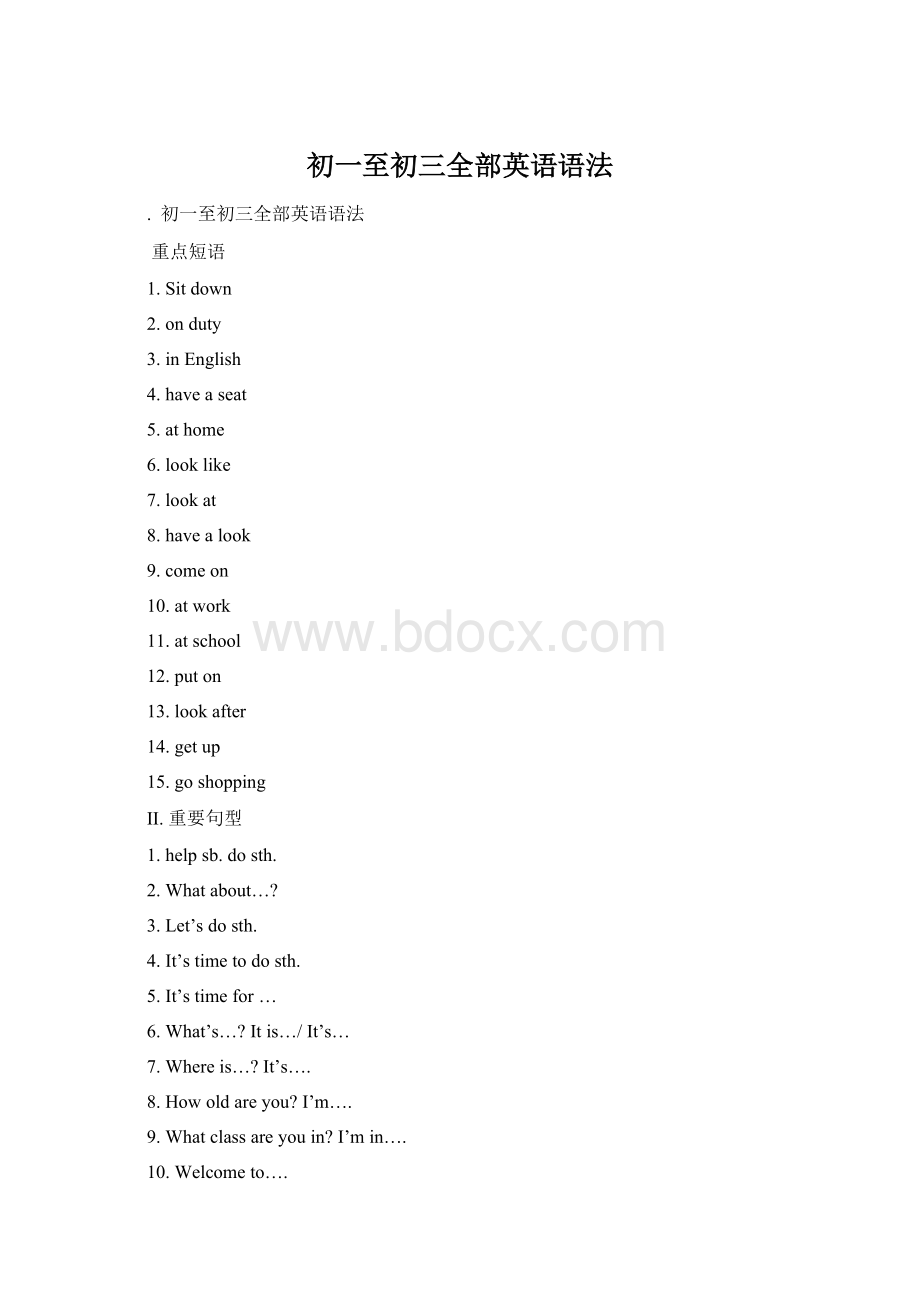初一至初三全部英语语法.docx
《初一至初三全部英语语法.docx》由会员分享,可在线阅读,更多相关《初一至初三全部英语语法.docx(22页珍藏版)》请在冰豆网上搜索。

初一至初三全部英语语法
.初一至初三全部英语语法
重点短语
1.Sitdown
2.onduty
3.inEnglish
4.haveaseat
5.athome
6.looklike
7.lookat
8.havealook
9.comeon
10.atwork
11.atschool
12.puton
13.lookafter
14.getup
15.goshopping
II.重要句型
1.helpsb.dosth.
2.Whatabout…?
3.Let’sdosth.
4.It’stimetodosth.
5.It’stimefor…
6.What’s…?
Itis…/It’s…
7.Whereis…?
It’s….
8.Howoldareyou?
I’m….
9.Whatclassareyouin?
I’min….
10.Welcometo….
11.What’s…plus…?
It’s….
12.Ithink…
13.Who’sthis?
Thisis….
14.Whatcanyousee?
Icansee….
15.Thereis(are)….
16.Whatcolourisit(arethey)?
It’s(They’re)…
17.Whose…isthis?
It’s….
18.Whattimeisit?
It’s….
III.交际用语
1.Goodmorning,Miss/Mr….
2.Hello!
Hi!
3.Nicetomeetyou.Nicetomeetyou,too.
4.Howareyou?
I’mfine,thankyou/thanks.Andyou?
5.Seeyou.Seeyoulater.
6.Thankyou!
You’rewelcome.
7.Goodbye!
Bye!
8.What’syourname?
Mynameis….
9.Hereyouare.Thisway,please.
10.Who’sondutytoday?
11.Let’sdo.
12.Letmesee.
IV.重要语法
1.动词be的用法;
2.人称代词和物主代词的用法;
3.名词的单复数和所有格的用法;
4.冠词的基本用法;
5.Therebe句型的用法。
【名师讲解】
1.in/on
在表示空间位置时,in表示在某个空间的范围以内,on表示在某一个物体的表面之上。
例如:
Thereisabirdinthetree.树上有只鸟。
Thereisapictureonthewall.墙上有张图。
2.this/that/these/those
(1)this常常用来指在时间、地点上更接近讲话人的人和事,these是this的复数形式。
that常常用来指在时间、地点上离讲话人更远一点的人和事,those时that的复数形式。
例如:
YoulookinthisboxandI’lllookinthatoneoverthere.你看看这个盒子,我去看那边的那个盒子。
Iwantthiscar,notthatcar.我想要这辆小汽车,不是那一辆。
Takethesebookstohisroom,please.请把这些书拿到他房间去。
Thisismine;that’syours.这个是我的,那个是你的。
Theseareapples;thoseareoranges.这些是苹果,那些是橘子。
(2)在打电话的用语中,this常常指的是我,that常常指的是对方。
例如:
ThisisMaryspeaking.Who’sthat?
我是玛丽。
你是谁?
3.Therebe/have
Therebe"有",其确切含意为"某处或某时存在某人或某物。
"其结构是:
Therebe+某人或某物+表示地点或时间的状语。
Therebe后面的名词实际上是主语,be动词的形式要和主语在数上保持一致,be动词后面的名词是单数或不可数名词时用is,名词是复数时用are。
例如:
(1)Thereisabigbottleofcokeonthetable.桌上有一大瓶子可乐。
(2)Thereisadollinthebox.那个盒子里有个娃娃。
(3)Therearemanyapplesonthetree.那树上有许多苹果。
总之,Therebe结构强调的是一种客观存在的"有"。
have表示"拥有,占有,具有",即:
某人有某物(sb.have/hassth.)。
主语一般是名词或代词,与主语是所属关系。
例如:
(4)Ihavetwobrothersandonesister.我有两个兄弟,一个姐姐。
(5)Thathousehasfourrooms.那所房子有四个房间。
4.look/see/watch
(1)look表示“看、瞧”,着重指认真看,强调看的动作,表示有意识地注意看,但不一定看到,以提醒对方注意。
,如:
Look!
Thechildrenareplayingcomputergames.瞧!
孩子们在玩电脑游戏。
Look!
What’sthatoverthere?
看!
那边那个是什么?
单独使用是不及物动词,如强调看某人/物,其后接介词at,才能带宾语,如:
He’slookingatme。
他正在看着我。
(2)see强调“看”的结果,着重的是look这个动作的结果,意思是“看到”,see是及物动词,后面能直接跟宾语。
如:
Whatcanyouseeinthepicture?
你能在图上看到什么?
Lookattheblackboard.Whatdidyouseeonit?
看黑板!
你看到了什么?
(3)watch“观看,注视”,侧重于场面,表示全神贯注地观看、观察或注视某事务的活动,强调过程,常用于“看电视、看足球、看演出”等。
如:
YesterdaywewatchedafootballmatchonTV.昨天我们从电视上看了一场足球比赛。
4.puton//in
puton意为“穿上,戴上”。
主要指“穿上”这一动作,后面接表示服装、鞋帽的名词。
in是介词,表示“穿着”强调状态。
在句中可以做定语、标语和状语。
如:
It’scoldoutside,putonyourcoat.外面冷,穿上你的外衣。
Heputsonhishatandgoesout. 他戴上帽子,走了出去。
ThewomaninawhiteblouseisJohn’smother.穿白色衬衣的那个妇女是John的妈妈。
5.house/home/family
house:
“房子”,指居住的建筑物;Home:
“家”,指一个人同家人共同经常居住的地方;Family:
“家庭“,“家庭成员”。
例如:
Pleasecometomyhousethisafternoon.今天下午请到我家来。
Heisnotathome.他不在家。
Myfamilyallgetupearly.我们全家都起得很早。
6.fine,nice,good,well
四者都可用作形容词表示"好"之意,但前三者既可作表语又可作定语,而后者仅用作表语。
主要区别在于:
(1)fine指物时表示的是质量上的"精细",形容人时表示的是"身体健康",也
可以用来指"天气晴朗"。
例如:
Yourparentsareveryfine.你父母身体很健康。
That'safinemachine.那是一台很好的机器。
It'safinedayforawalktoday.今天是散步的好时候。
(2)nice主要侧重于人或物的外表,有"美好","漂亮"的意思,也可用于问候或赞扬别人。
例如:
Lucylooksnice.露西看上去很漂亮。
Thesecoatsareverynice.那些裙子很好看。
Nicetomeetyou.见到你很高兴。
It'sveryniceofyou.你真好。
(3)good形容人时指"品德好",形容物时指"质量好",是表示人或物各方面都好的普通用语。
例如:
Hersonisagoodstudent.她儿子是一个好学生。
Theredcarisverygood.那辆红色小汽车很好。
(4)well只可用来形容人的"身体好",但不能作定语,它也能用作副词作状语,多放在所修饰的动词之后。
例如:
I'mverywell,thanks.我身体很好,谢谢。
Myfriendssingwell.我的朋友们歌唱得好。
【考点扫描】
中考考点在本单元主要集中在:
1.动词be的用法;
2.人称代词和物主代词的用法;
3.名词的单复数和所有格的用法;
4.冠词的基本用法;
5.Therebe句型的用法。
6.本单元学过的词汇、短语和句型;
7.本单元学过的日常交际用语。
考试形式可以是单项填空、完型填空、短文填空、完成句子。
【中考范例】
1.(2004年北京市中考试题)
Mary,pleaseshow________yourpicture.
A.my B.mine C.I D.me
【解析】答案:
D。
该题考查的是人称代词和物主代词的用法。
本题中动词show后面跟双宾语,空白处应填入人称代词的宾格me作宾语。
2.(2004年上海市徐汇区中考试题)
_________orangeonthedeskisforyou,Mike.
A.A B.An C./ D.The
【解析】答案:
D。
该题考查的是冠词的基本用法。
因为是特指课桌上的那个橘子,所以用定冠词the。
3.(2004年哈尔滨市中考试题)
---What_______thenumberofthegirlsinyourclass?
---Abouttwenty.
A.is B.am C.are D.be
【解析】答案:
A。
该题考查的是动词be的用法和主谓一致。
thenumber作主语,应该是单数第三人称,动词be变为is。
4.(2004年陕西省中考试题)
There_______afootballmatchonTVthisevening.
A.willhave B.isgoingtobe C.has D.isgoingtohave
【解析】答案:
B。
该题考查的是Therebe…句型和动词have用法区别。
Therebe句型本身就表示“在某个地方存在某个人或物”,不能和动词have混在一起用。
【满分演练】
单项填空
1.---Whatcolouristhebike?
---It’s_______orange.
A.an B.a C./ D.the
2.Thatisn’therbag.It’s________.
A.my B.I C.mine D.me
3.---Oh,yourkiteisverynice.
---__________________.
A.That’sright B.No,it’snotnice C.Yes,itis D.Thankyou
4.Thewomanissixty,butshe_______young.
A.is B.sees C.looks D.watches
5.It’stime________lunch.Let’sgohome.
A.to B.in C.for D.on
6.---________isyourcoat?
---Theblackone.
A.What B.Where C.Which D.How
7.---________isthetoy?
---It’sonthebed.
A.Who B.Where C.What D.Whose
8.Theshoesaretooold.Put________overthere.
A.it B.they C.their D.them
9.Excuseme.Canyou_______mywatch,please?
A.look B.looklike C.lookafter D.lookat
10.Look_______theblackboardandlisten_______theteacher.
A.// B.at;to C.after;/ D.on;after
11.---Whosedressisthis?
---It’s_________.
A.Lucy B.Lucy’s C.Jim D.Jim’s
12.Thegirl______thepurplecoatishissister.
A.at B.in C.on D.with
13.Thereisabird______thetree.
A.in B.on C.to D.of
14.Therearemany________inourschool.
A.womanteachers B.womanteacher
C.womenteacher D.womenteachers
15.---Isthereaballunderthedesk?
---______________________.
A.Yes,itis B.Yes,there’s
C.No,thereisn’t D.No,thereis
16.There_______somebooksandapencilonthedesk.
A.am B.is C.are D.be
17.---Letmehelpyou.
---_______________.
A.You’rewelcome B.Thanksverymuch
C.Don’tworry D.Yes,thanks
18.______oldmanis______Englishteacher.
A.The;an B.An;an C.The;the D.A;a
19.---What_____fiveplussix?
---It’seleven.
A.am B.is C.are D./
20.---What______youseeinthepicture?
---Icanseesomeflowers.
A.must B.can C.are D.do
二.用所给单词的适当形式填空
1.________(He)penisin______(I)pencil-box.
2.________(You)shoes________(be)underthebed.
3.________(Who)newruleristhis?
4.---Arethesetrousers_______(you)?
---No,theyaren’t________(we)
5.It’stime________(go)andplaygames.
6.Thisismypen.Pleasegiveitto________(I).
7.Ihavetwo________(baby).
8.Look!
Thatisa________(China)car.
9.Itis__________(myteacher)sweater.
10.Nowher________(parent)areinAmerica.
初一年级(下)
【知识梳理】
I.重点短语
1.abottleof
2.alittle
3.alot(of)
4.allday
5.befrom
6.beover
7.comeback
8.comefrom
9.doone’shomework
10.dotheshopping
11.getdown
12.gethome
13.getto
14.getup
15.goshopping
16.haveadrinkof
17.havealook
18.havebreakfast
19.havelunch
20.havesupper
21.listento
22.not…atall
23.put…away
24.takeoff
25.throwitlikethat
26.wouldlike
27.inthemiddleoftheday
28.inthemorning/afternoon/evening
29.onafarm
30.inafactory
II.重要句型
1.Letsb.dosth.
2.Couldsb.dosth.?
3.wouldlikesth.
4.wouldliketodosth.
5.Whataboutsomethingtoeat?
6.Howdoyouspell…?
7.MayIborrow…?
III.交际用语
1.—Thanksverymuch!
—You'rewelcome.
2.Putit/themaway.
3.What'swrong?
4.Ithinkso.
Idon'tthinkso.
5.Iwanttotakesomebookstotheclassroom.
6.Givemeabottleoforangejuice,please.
Pleasegiveit/thembacktomorrow.OK.
9.What'syourfavouritesport?
10.Don'tworry.
11.I’m(not)goodatbasketball.
12.Doyouwantago?
13.That'sright./That‘sallright./Allright.
14.Doyouhaveadictionary/anydictionaries?
Yes,Ido./No,Idon’t.
15.We/TheyhavesomeCDs.
We/Theydon’thaveanyCDs.
16.---Whatdayisittoday/tomorrow?
---It’sMonday.
17.---MayIborrowyourcolourpens,please?
---Certainly.Hereyouare.
18.---Whereareyoufrom?
---FromBeijing.
19.What'syourtelephonenumberinNewYork?
20.---Doyoulikehotdogs?
---Yes,Ido.(Alittle./Alot./Verymuch.)
---No,Idon't.(Idon'tlikethematall.)
21.---Whatdoesyourmotherlike?
---Shelikesdumplingsandvegetablesverymuch.
22.---Whendoyougotoschooleveryday?
---Igotoschoolat7:
00everyday.
23.---Whattimedoeshegotobedintheevening?
---Hegoestobedat10:
00.
IV.重要语法
1.人称代词的用法;
2.祈使句;
3.现在进行时的构成和用法;
4.动词have的用法;
5.一般现在时构成和用法;
6.可数名词和不可数名词的构成和用法
【名师讲解】
1. That'sright./That‘sallright./Allright.
That’sright意为“对的”,表示赞同对方的意见、看法或行为,肯定对方的答案或判断。
例如:
"Ithinkwemusthelptheoldman.""我想我们应该帮助这位老人。
"
"That'sright."或"You'reright.""说得对"。
That’sallright.意为“不用谢”、“没关系”,用来回答对方的致谢或道歉。
例如:
"Manythanks.""That'sallright."
"Sorry.It'sbroken.""That'sallright."
Allright.意为“行了”、“可以”,表示同意对方的建议或要求。
有时还可以表示“身体很好”
"Pleasetellmeaboutit.""请把此事告诉我。
"
"Allright.""好吧。
"
Isyourmotherallright?
你妈身体好吗
2.make/do
这两个词都可以解释为“做”,但含义却不同,不能混用。
make指做东西或制东西,do指做一件具体的事。
Canyoumakeapaperboat